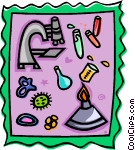Teaching several subjects
By Mary Bigelow
Posted on 2010-04-21
 I’ve been teaching biology for the past three years. Next year, based on student interest, the science department wants to add a biology elective in human anatomy/physiology. I’d love to teach this, but I would have three sections of biology and two sections of the elective. Is it common for teachers to have more than one preparation? How can I minimize the affect on my teaching?
I’ve been teaching biology for the past three years. Next year, based on student interest, the science department wants to add a biology elective in human anatomy/physiology. I’d love to teach this, but I would have three sections of biology and two sections of the elective. Is it common for teachers to have more than one preparation? How can I minimize the affect on my teaching?
—Angela, Worcester, Massachusetts
I’ve worked with many small schools where teaching more than one subject is the rule, not the exception. Even in larger schools, it’s very common for a teacher to have multiple preparations, based on student enrollment in required courses, the scope of electives, teachers’ areas of certification, and sometimes seniority. (At the university level, I taught three different courses each semester.)
The obvious advantage of teaching just one course is in the planning time—you can concentrate your time and efforts on that subject. But you’ve had several years of teaching biology, so you should have a repertoire of lesson plans, instructional strategies, lab investigations, and assessments you use or revise for that course. The new elective will have to be designed from the ground up, but you’ll have an opportunity to incorporate your own interests and expertise with the science standards and curriculum goals.
As an elective, the course should attract students interested in the topic. If you previously taught the students in the required biology course, it could be interesting to work with them in advanced topics and investigations. I found teaching an elective to be a more relaxed situation. The students were familiar with class routines and procedures; I already knew their backgrounds and interests.
I actually enjoyed teaching more than one course. When I taught six sections of life science, it was hard to remember at the end of the day what was discussed in each class. I had to draw on my acting and presentation skills to make the last period as engaging as the first, and I had to remember that even if I had heard a question five times already, to a student in the last class it was a new idea. I found teaching more than one course was intellectually challenging, and I appreciated the opportunity to update my own content and skills in more than one specialized area.
Be sure to check out the NSTA Learning Center and SciLinks for resources and ideas as you work on your new course.
Another advantage of teaching more than one course is you can schedule tests, projects, student presentations, and notebook reviews at different times, spreading out the paperwork with careful planning. With six sections, I often spent the Saturdays at school grading 150 projects, research papers, or lab notebooks, in addition to the paperwork I could take home during the week.
You can use many strategies to keep yourself (and the students) organized. Try not to have two different labs on the same day. Divide your bulletin boards and shelves into two separate areas so students in each course know where things are and where to turn in their assignments. I used a different logo for each course, putting it in the upper right corner of handouts, quizzes, or other documents. I used separate three-ring binders and separate folders (with the same logo) on my laptop for each course to organize lesson plans and other resources. I also had a briefcase for each course to keep material from getting mixed up.
I don’t know of any research on the topic of multiple preparations, but I think a more serious issue is a science teacher having to travel from one classroom to another, regardless of the number of preparations.
Disclaimer: The views expressed in this blog post are those of the author(s) and do not necessarily reflect the official position of the National Science Teaching Association (NSTA).


